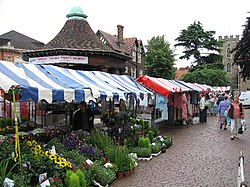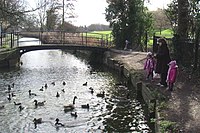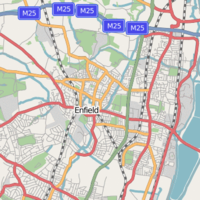Enfield
| Enfield | |
| Middlesex | |
|---|---|
 Enfield Market Square | |
| Location | |
| Grid reference: | TQ325965 |
| Location: | 51°39’6"N, 0°5’1"W |
| Data | |
| Post town: | Enfield |
| Postcode: | EN1, EN2 |
| Dialling code: | 020 |
| Local Government | |
| Council: | Enfield |
| Parliamentary constituency: |
Enfield North |
Enfield sometimes known as Enfield Town is a pleasant Middlesex town in the northern part of the county. It is a suburban town contiguous with but at the edge of the wider conurbation. The town centre is at the stretch of Church Street called "The Town", by the market place, and the streets reaching out from there. It and has a full range of shops and residential roads.
The area is identified in the "London Plan" as one of 35 major centres in the "Greater London" area.[1]
A disused section of the New River runs through the centre of Enfield Town, where it is called the "New River Loop". Water levels are still maintained in it, and it survives as an important local amenity.
History
Historically, Enfield was a collection of small communities spread around the royal hunting grounds of Enfield Chase. Its name likeliest came from the Old English Eanafeld or similar, meaning "open land belonging to a man called Eana" or "open land for lambs". In the Domesday Book of 1086 it is recorded as Enefelde, and had a priest who almost certainly presided at St Andrews Church. By 1572 most of the basic street layout had been completed. The village green later became the historic marketplace between the church and where the fountain now stands. A market is still operated in this area, which is owned by the parish charity.
In Tudor days, the royal Palace of Enfield was a favoured royal residence, of which nothing now remains but a carved stone fireplace presently located in one of the houses of Gentleman's Row, the site buried beneath the Palace Gardens Shopping Centre. Gentleman's Row remains, a street of fine sixteenth to eighteenth century houses by Enfield's town centre. It was at Enfield Palace that the future Queen Elizabeth I lived while a princess, and she was there during the final illness of her father Henry VIII. Edward Price of Wales was taken to Enfield to join her, so that in the company of his sister Edward Seymour, 1st Earl of Hertford, could break the news to Edward, formally announcing the death of their royal father, in the presence chamber at Enfield, on his knees to make formal obeisance to the boy as King. After her accession in turn, Good Queen Bess held court there. Palace Gardens is built on the site of the palace and bears memory of it in its name.
The New River was built in the reign of King James I to supply water to London from Great Amwell in Hertfordshire, and runs immediately behind the town centre through the Town Park, which is the last remaining public open space of Enfield Old Park. The Enfield Loop of the New River also passes through the playing fields of Enfield Grammar School, and this is the only stretch of the loop without a public footpath on at least one side of it.

The poet John Keats went to Clarke's Scho|l in Enfield, where he began a translation of the Aeneid. Barely five feet tall, Keats was not known at school for his enthusiasm for books, but his fighting. "My mind has been the most discontented and restless one that ever was put into a body too small for it," he wrote. The school's building later became Enfield Town railway station, until it was demolished in 1872. The current building was erected in the 1960s. In 1840 the first section of the Northern and Eastern Railway had been opened from Stratford, Essex to Broxbourne, Hertfordshire. The branch line from Water Lane to Enfield Town station was opened in 1849.
In the nineteenth century the Royal Small Arms factory, which produced the famous Enfield and Lee-Enfield Rifles. The workers of the factory went on to put their handiwork to good use, forming amongst themselves one of the many volunteer rifle corps founded in the later half of the nineteenth century.
In 1967 Enfield became the site of the world's first ever cash machine or "automatic teller machine", which was installed at the branch of Barclays Bank on 27 June 1967 by Ron Bates, and opened by the actor Reg Varney.[2]

Nearby localities
References
- ↑ Mayor of London (February 2008). "London Plan (Consolidated with Alterations since 2004)". Greater London Authority. http://www.london.gov.uk/thelondonplan/docs/londonplan08.pdf.
- ↑ "The man who invented the cash machine". BBC News. June 25, 2007. http://news.bbc.co.uk/1/hi/business/6230194.stm. Retrieved May 2, 2010.